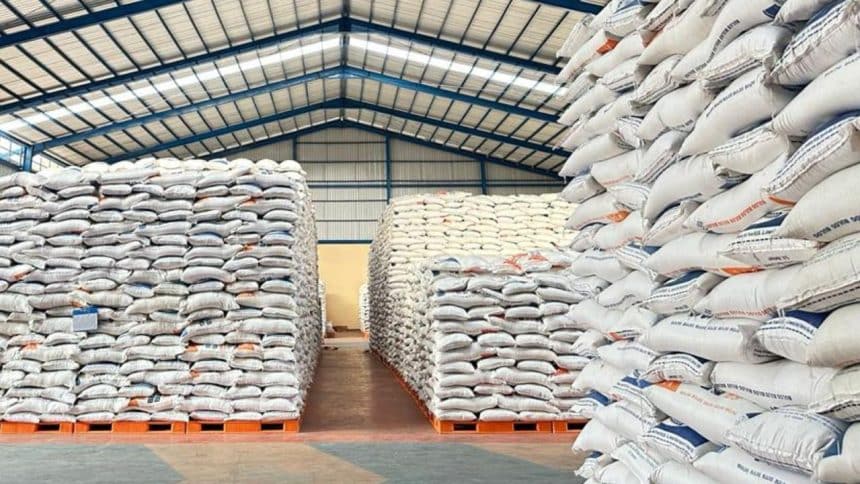The government plans to build 100 new Bulog warehouses as part of its strategy to strengthen national food security. With significantly larger rice storage capacity, Indonesia hopes to secure stocks, streamline distribution, and minimize the risk of shortages. However, behind this significant opportunity, there is one key factor that should not be overlooked: risk protection through warehouse insurance.
In the food industry, especially rice storage, the risks are real. They range from fires and silo leaks to floods and machine breakdowns to theft. Without proper protection, losses can balloon into the billions of rupiah in a matter of hours.
This article will discuss:
- Types of insurance that must be owned by Bulog warehouses
- Major risks in the rice storage sector
- Why is an OJK-approved insurance broker like L&G Insurance Broker the best choice, not an agent and not buying directly from an insurance company?
- How claims assistance works until payment is guaranteed
Want to know the best type of protection for your warehousing business? Get a FREE consultation with a risk expert L&G Insurance Broker through:
Whatsapp 08118507773 or Email halo@lngrisk.co.id
Why is the Government Building 100 New Bulog Warehouses?
This massive development is more than just an ordinary infrastructure project. There are several compelling reasons:
- The Need for Price Stabilization
With large, modern warehouses, Bulog can more effectively maintain rice price stability. Seasonal fluctuations are no longer a major threat.
- Increasing Rice Storage Capacity
National storage capacity has been limited, resulting in stockpiles in some areas often going unaddressed. This new warehouse solves this problem.
- Supply Chain Optimization
Warehouses spread across many regions in Indonesia help maintain rice quality while speeding up distribution to remote areas.
However, the larger the assets under management, the greater the risks that must be protected. This is where the role of warehouse insurance become very critical.
Major Risks in Rice Warehouse and Storage Management
Warehouse management isn’t just about keeping things tidy. There are significant risks that often go unnoticed:
- Fire Risk
Fire remains the biggest threat to the warehousing sector. Many incidents occur due to short circuits, worker negligence, or machine malfunction.
Losses may include:
- Totally damaged rice
- Warehouse facilities destroyed
- Operational disruption 3–6 months
- Financial losses of billions of rupiah
Without insurance, damage of this magnitude is almost impossible to recover quickly.
- Floods and Weather Damage
Indonesia is a disaster-prone country. Warehouses located in low-lying areas are highly vulnerable to flooding.
This risk can cause:
- Wet rice → rotten
- Quality drops → cannot be sold
- Rejection from buyer
Warehouse insurance must cover the risks of flooding and extreme weather.
- Theft and Vandalism
Rice warehouses are frequently targeted by theft, both internally and externally. Every kilogram of rice remains valuable, especially when market prices are high.
- Engine & Ventilation System Damage
When storing rice, temperature and humidity control are crucial. If the cooling or ventilation system is damaged:
- Rice can be infested with weevils
- Rice changes color
- Quality drops drastically
Damage like this can cause total loss.
- Operational Risk of Labor
Including work accidents, human error, or negligence of forklift operators which can cause rice pallets to fall.
Types of Insurance Required for Rice Warehouses
The following is a list of protections that must be in place for companies that manage warehouses, especially for rice storage:
Mandatory number one.
Protects from:
- Fire
- Explosion
- Flood
- Hurricane / typhoon
- Earthquake (optional)
- Damage due to accident
- Electrical system failure
This coverage is very broad and is the foundation of warehouse protection.
- Flood & Natural Disaster Insurance Extension
Use if the warehouse is located at:
- lowlands
- near the river
- areas with a history of flooding
- Burglary / Theft Insurance
Protecting rice stocks from theft, both internal and external.
Machine broken = storage failed = stock damaged.
This insurance saves a lot of losses.
If the warehouse is unable to operate due to an incident, the business still receives financial compensation.
Protects against legal risks resulting from accidents involving workers, guests, vendors, or third parties.
Why Must Rice Warehouses Be Protected by an Official Broker Registered with the OJK?
This is the most important part for readers.
- Don’t Buy Through an Agent
Agents work for one insurance company. They can only offer a limited range of products.
Risk:
- The product does not meet your needs
- Premium prices can be higher
- No professional claims assistance
- Don’t Buy Directly from the Insurance Company
Without a broker, you will:
- Negotiating alone (and usually losing)
- Don’t understand the policy details
- No companion when claiming
- OJK Official Insurance Broker = Total Protection
L&G Insurance Broker:
- Working in the interests of the client (not the insurance company)
- Access multiple insurance companies to get the best prices & benefits
- Handling documents, negotiations, and policy placement
- Claims support until payment
- Legal, supervised by OJK, and trusted
There is no reason to choose another path.
Real Example of Losing a Warehouse Without Insurance
Here’s a simple overview:
Case 1 — Warehouse Fire
Loss value:
- Rice stock: Rp. 18 billion
- Building: Rp. 12 billion
- Total: Rp. 30 billion
Without insurance? The company goes bankrupt.
Case 2 — Ventilation Machine Failure
50% of rice stocks were damaged due to humidity and mold. Loss estimated at Rp 4.5 billion.
If you have Machinery Breakdown + Stock Deterioration, the loss can be replaced.
If you have a rice warehouse, storage facility, or are preparing food infrastructure, don’t wait until a loss occurs.
Contact L&G Insurance Broker for a FREE risk review:
OF08118507773 or Email halo@lngrisk.co.id
Recommended Protection Packages for Bulog Warehouses
For the case of building 100 new Bulog warehouses, the following package is ideal:
Package A – Basic Protection
- Fire Insurance
- Burglary Insurance
Package B – Complete Protection
- Property All Risks
- Machinery Breakdown
- Flood & Natural Disaster
- Liability Insurance
Package C – Full Protection (L&G Recommendation)
- Industrial All Risks
- Business Interruption
- Theft & Burglary
- Machinery Breakdown + Stock Deterioration
- Employer Liability
- Public Liability
This is the most suitable package for large projects like this.
Conclusion
The construction of 100 new Bulog warehouses is a major step by the government to strengthen national food security. However, such a significant asset must be protected with maximum protection. Risks such as fire, flooding, theft, and system failures can cause billions of rupiah in losses if not properly managed.
Therefore, rice storage businesses MUST have:
- Warehouse insurance
- Industrial risk protection
- Stock & facility protection
And most importantly: never buy insurance through an agent or directly from an insurance company.
Use an OJK-authorized broker such as L&G Insurance Broker which will help:
- Get the best policy according to your needs
- The most efficient price
- Claims support until completion and paid
Protect your warehouse assets from major risks today! Click for a FREE consultation:
📱 Whatsapp: 08118507773
📧 Email: halo@lngrisk.co.id













